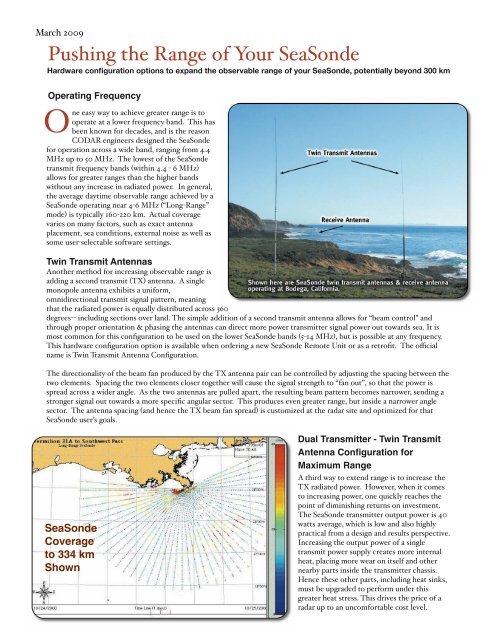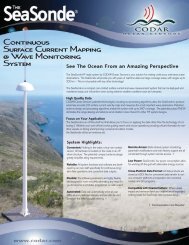SSonde_Cat_rev201003.. - CODAR Ocean Sensors
SSonde_Cat_rev201003.. - CODAR Ocean Sensors
SSonde_Cat_rev201003.. - CODAR Ocean Sensors
You also want an ePaper? Increase the reach of your titles
YUMPU automatically turns print PDFs into web optimized ePapers that Google loves.
March 2009<br />
Pushing the Range of Your SeaSonde<br />
Hardware configuration options to expand the observable range of your SeaSonde, potentially beyond 300 km<br />
Operating Frequency<br />
One easy way to achieve greater range is to<br />
operate at a lower frequency band. This has<br />
been known for decades, and is the reason<br />
<strong>CODAR</strong> engineers designed the SeaSonde<br />
for operation across a wide band, ranging from 4.4<br />
MHz up to 50 MHz. The lowest of the SeaSonde<br />
transmit frequency bands within 4.4 6 MHz<br />
allows for greater ranges than the higher bands<br />
without any increase in radiated power. In general,<br />
the average daytime observable range achieved by a<br />
SeaSonde operating near 46 MHz LongRange<br />
mode is typically 160220 km. Actual coverage<br />
varies on many factors, such as exact antenna<br />
placement, sea conditions, external noise as well as<br />
some userselectable software settings.<br />
Twin Transmit Antennas<br />
Another method for increasing observable range is<br />
adding a second transmit TX antenna. A single<br />
monopole antenna exhibits a uniform,<br />
omnidirectional transmit signal pattern, meaning<br />
that the radiated power is equally distributed across 360<br />
degrees including sections over land. The simple addition of a second transmit antenna allows for beam control and<br />
through proper orientation & phasing the antennas can direct more power transmitter signal power out towards sea. It is<br />
most common for this conguration to be used on the lower SeaSonde bands 514 MHz, but is possible at any frequency.<br />
This hardware conguration option is available when ordering a new SeaSonde Remote Unit or as a retrot. The ocial<br />
name is Twin Transmit Antenna Conguration.<br />
The directionality of the beam fan produced by the TX antenna pair can be controlled by adjusting the spacing between the<br />
two elements. Spacing the two elements closer together will cause the signal strength to fan out, so that the power is<br />
spread across a wider angle. As the two antennas are pulled apart, the resulting beam pattern becomes narrower, sending a<br />
stronger signal out towards a more specic angular sector. This produces even greater range, but inside a narrower angle<br />
sector. The antenna spacing and hence the TX beam fan spread is customized at the radar site and optimized for that<br />
SeaSonde users goals.<br />
SeaSonde<br />
Coverage<br />
to 334 km<br />
Shown<br />
Dual Transmitter - Twin Transmit<br />
Antenna Configuration for<br />
Maximum Range<br />
A third way to extend range is to increase the<br />
TX radiated power. However, when it comes<br />
to increasing power, one quickly reaches the<br />
point of diminishing returns on investment.<br />
The SeaSonde transmitter output power is 40<br />
watts average, which is low and also highly<br />
practical from a design and results perspective.<br />
Increasing the output power of a single<br />
transmit power supply creates more internal<br />
heat, placing more wear on itself and other<br />
nearby parts inside the transmitter chassis.<br />
Hence these other parts, including heat sinks,<br />
must be upgraded to perform under this<br />
greater heat stress. This drives the price of a<br />
radar up to an uncomfortable cost level.




